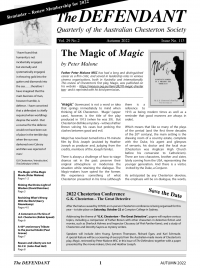George Orwell criticized C.S. Lewis’s 1945 novel That Hideous Strength for its supernatural elements. John-Paul Heil, a PhD candidate in history at the University of Chicago and adjunct professor at Mount St. Mary’s University in Maryland, argues that this is precisely what connects Lewis’ and Chesterton’s notions of conversion.
C.S. Lewis’s That Hideous Strength is a novel about conversion. Released in 1945, this third part of Lewis’s Space Trilogy was reviewed by George Orwell, who despite thinking that “by the standard of the novels appearing nowadays this is a book worth reading,” critiqued how “the supernatural keeps breaking in” to the story’s proceedings in “rather confusing” ways.
He also observed that “Mr. Lewis probably owes something to Chesterton as a writer.”
Orwell was right on all but one count: the “undisciplined ways” the supernatural enters Lewis’s story provide the engine of its protagonists’ conversions and further reveal Lewis’s debt to Chesterton. In his 1926 essay “The Catholic Church and Conversion,” Chesterton emphasizes that though no two conversion stories are the same, what connects them all is a shared recognition of Truth, the reality of things as they are.
Lewis’s novel celebrates the “supreme sacredness and value of two things: Reason and Liberty” which Chesterton argues can “justify the whole Catholic theology.”
Lewis’s protagonists, Mark and Jane Studdock, are nonbelievers looking for reason and liberty. Recently married yet already tired of one another, the pair find themselves pulled apart.
Mark, attempting to climb the academic career ladder, becomes entangled with the National Institute of Co-ordinated Experiments (N.I.C.E.), an influential cabal he believes is rationally and scientifically working towards “the preservation and extension” of humanity. Jane desires liberty via marital equality and balks at the idea of obeying anyone, much less her husband.
Mark eventually learns of the Institute’s alliance with demonic powers and their true plan, to transform the “intellectual nucleus” of humanity into “the race itself,” jettisoning the rest, as the “human race is to become all Technocracy” by means of a technologized spirituality.
To prepare him to cooperate with the N.I.C.E.’s diabolical patron, Mark is held captive and eventually
brought to step on a crucifix. Though he believes Christianity “a fable,” he finds himself “looking at the crucifix in a new way…as a bit of history” which represents “an image of the Straight” and truly novel “Normal” opposed to the Institute’s crooked technocracy.
Mark rejects this desecration, in Chesterton’s words, “out of contempt [for] the evil by which he has been surrounded.” We are close to Chesterton’s observation that “the Catholic Church is the only thing which saves a man from the degrading slavery of being a child of his age.”
Though the ragtag resistance movement against the Institute tries to recruit Jane, she initially resists, as joining them would mean giving herself to them and subjugating her will to their unseen director. Jane holds firm to her faulty notion of freedom until she meets this director: Elwin Ransom, the protagonist of the trilogy’s first two novels, whose time on the sinless Venus has left him in an Edenic but crippled body. His natural and moral rectitude, his Adamic kingliness, and the goodness of his reality inspire Jane to consider things which never, “till that moment, seemed to be connected with real life.”
Ransom reveals the real reason for her marital difficulties: “you do not fail in obedience through lack of love, but have lost love because you never attempted obedience.”
Jane pledges obedience to Ransom as the convert pledges obedience to the Church, “for beauty was made for others. Her beauty belonged to the Director. It belonged to him so completely that he could even decide not to keep it for himself but to order that it be given to another, by an act of obedience lower, and therefore higher, more unconditional and therefore more delighting, than if he had demanded it for himself.”
The supernatural, ever “confusing” and “undisciplined” to human eyes, breaks into Mark and Jane’s lives and provides the means for their conversions and reconciliation. Lewis was not Catholic, but his novel is certainly contained in the “great dome” of its Truth.
